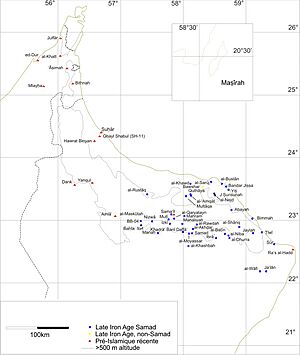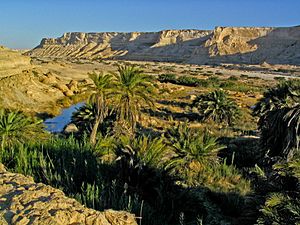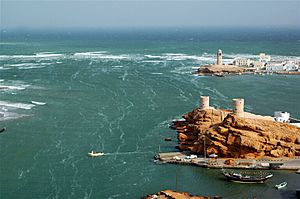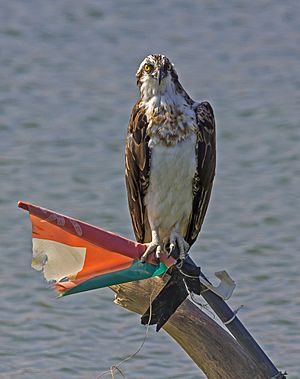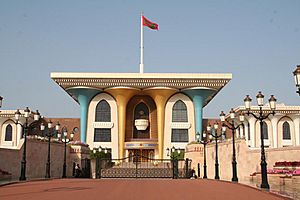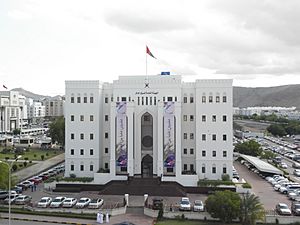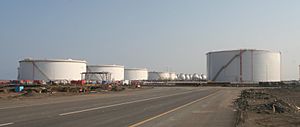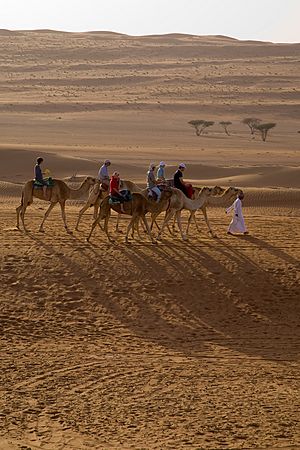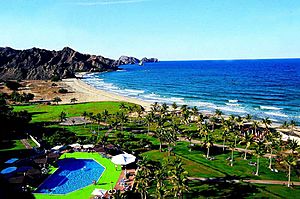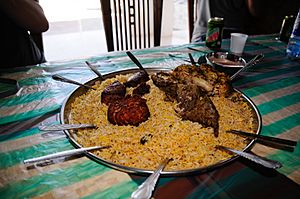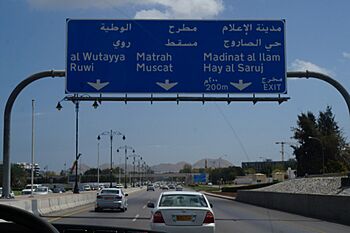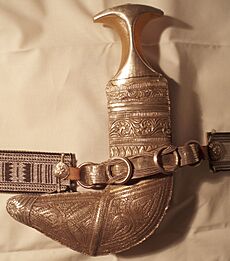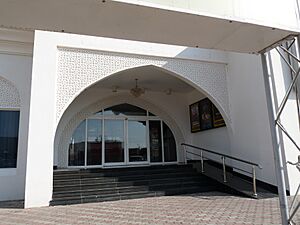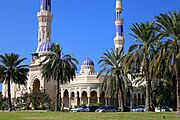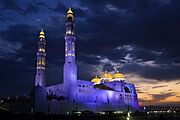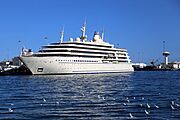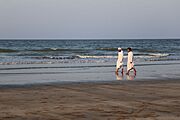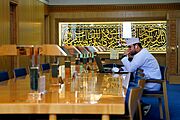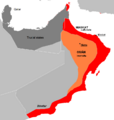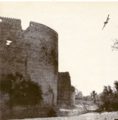Oman facts for kids
Quick facts for kids
Sultanate of Oman
|
|
|---|---|
|
Anthem: نشيد السلام السلطاني
"as-Salām as-Sultānī" "Sultanic Salutation" |
|
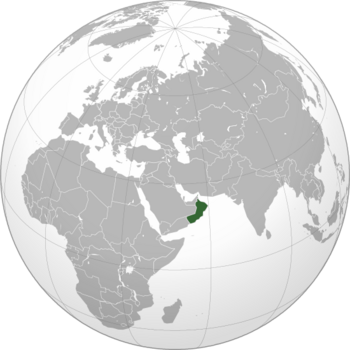
Location of Oman (dark green)
|
|
| Capital and largest city
|
Muscat 23°35′20″N 58°24′30″E / 23.58889°N 58.40833°E |
| Official languages | Arabic |
| Religion
(2023)
|
|
| Demonym(s) | Omani |
| Government | Unitary Islamic absolute monarchy |
|
• Sultan
|
Haitham bin Tariq |
| Theyazin bin Haitham | |
| Legislature | Council of Oman |
| Council of State (Majlis al-Dawla) | |
| Consultative Assembly (Majlis al-Shura) | |
| Establishment | |
|
• Azd tribe migration
|
130 |
|
• Al-Julandie
|
629 |
|
• Imamate established
|
751 |
|
• Nabhani dynasty
|
1154 |
|
• Portuguese rule
|
1507–1656 |
|
• Yarubi dynasty
|
1624 |
|
• Al Said dynasty
|
1744 |
| 8 January 1856 | |
|
• Sultanate of Oman
|
9 August 1970 |
|
• Basic Statute
|
6 November 1996 (established); 2011 (amended); 2021 (amended) |
| Area | |
|
• Total
|
309,500 km2 (119,500 sq mi) (70th) |
|
• Water (%)
|
negligible |
| Population | |
|
• 2018 estimate
|
4,829,473 (125th) |
|
• 2010 census
|
2,773,479 |
|
• Density
|
15/km2 (38.8/sq mi) (177th) |
| GDP (PPP) | 2023 estimate |
|
• Total
|
|
|
• Per capita
|
|
| GDP (nominal) | 2023 estimate |
|
• Total
|
|
|
• Per capita
|
|
| Gini (2018) | 30.75 medium |
| HDI (2022) | very high · 59th |
| Currency | Omani rial (OMR) |
| Time zone | UTC+4 (GST) |
| DST is not observed. | |
| Date format | dd.mm.yyyy |
| Driving side | right |
| Calling code | +968 |
| ISO 3166 code | OM |
| Internet TLD | .om, عمان. |
|
Website
www.oman.om |
|
The Sultanate of Oman is a country in the southwestern part of Asia, on the southeast coast of the Arabian Peninsula. It borders the United Arab Emirates to the northwest, Saudi Arabia to the west, and Yemen to the southwest, it also shares a marine border with Pakistan to the north-east. The coast is formed by the Arabian Sea to the south and east, and the Gulf of Oman to the northeast.
The country is a monarchy. The capital of the Sultanate is Muscat.
Contents
History

At Aybut Al Auwal, in the Dhofar Governorate of Oman, a site was discovered in 2011 containing more than 100 surface scatters of stone tools, belonging to a regionally specific African lithic industry—the late Nubian Complex—known previously only from the northeast and Horn of Africa. Two optically stimulated luminescence age estimates place the Arabian Nubian Complex at 106,000 years old. This supports the proposition that early human populations moved from Africa into Arabia during the Late Pleistocene.
In recent years surveys have uncovered Palaeolithic and Neolithic sites on the eastern coast. Main Palaeolithic sites include Saiwan-Ghunaim in the Barr al-Hikman. Archaeological remains are particularly numerous for the Bronze Age Umm an-Nar and Wadi Suq periods. At the archaeological sites of Bat, Al-Janah, and Al-Ayn wheel-turned pottery, hand-made stone vessels, metals industry artifacts, and monumental architecture have been preserved.
During the 8th century BCE, it is believed that the Yaarub, the descendant of Qahtan, ruled the entire region of Yemen, including Oman. Wathil bin Himyar bin Abd-Shams (Saba) bin Yashjub (Yaman) bin Yarub bin Qahtan later ruled Oman. It is thus believed that the Yaarubah were the first settlers in Oman from Yemen.
In the 6th century BCE, the Achaemenids exerted control over the Omani peninsula, most likely ruling from a coastal centre such as Suhar. Central Oman has its own indigenous Samad Late Iron Age cultural assemblage named eponymously from Samad al-Shan. In the northern part of the Oman Peninsula the Recent Pre-Islamic Period begins in the 3rd century BCE and extends into the 3rd century CE. Whether or not Persians brought south-eastern Arabia under their control is a moot point, since the lack of Persian archeological finds speak against this belief.
From the 17th century, the Omani Sultanate was an empire, vying with the Portuguese and British empires for influence in the Persian Gulf and the Indian Ocean. At its peak in the 19th century, Omani influence and control extended across the Strait of Hormuz to Iran and Pakistan, and as far south as Zanzibar. In the 20th century, the sultanate came under the influence of the United Kingdom. For over 300 years, the relations built between the two empires were based on mutual benefit. The UK recognized Oman's geographical importance as a trading hub that secured British trading-lanes in the Persian Gulf and Indian Ocean and protected London's interests in the Indian sub-continent. Oman is an absolute monarchy led by a sultan, with power passed down through the male line. Qaboos bin Said was the Sultan from 1970 until his death on 10 January 2020. Qaboos, who died childless, had named his cousin, Haitham bin Tariq, as his successor in a letter, and the ruling family confirmed him as the new Sultan of Oman.
Formerly a maritime empire, Oman is the oldest continuously independent state in the Arab world. It is a member of the United Nations, the Arab League, the Gulf Cooperation Council, the Non-Aligned Movement, and the Organisation of Islamic Cooperation.
Geography
Oman lies between latitudes 16° and 28° N, and longitudes 52° and 60° E. A vast gravel desert plain covers most of central Oman, with mountain ranges along the north (Al Hajar Mountains) and southeast coast (Qara or Dhofar Mountains), where the country's main cities are also located: the capital city Muscat, Sohar and Sur in the north, and Salalah in the south. Oman's climate is hot and dry in the interior and humid along the coast. During past epochs, Oman was covered by ocean, witnessed by the large numbers of fossilized shells existing in areas of the desert away from the modern coastline.
The peninsula of Musandam (Musandem) exclave, which has a strategic location on the Strait of Hormuz, is separated from the rest of Oman by the United Arab Emirates. The series of small towns known collectively as Dibba are the gateway to the Musandam peninsula on land and the fishing villages of Musandam by sea, with boats available for hire at Khasab for trips into the Musandam peninsula by sea.
Oman's other exclave, inside UAE territory, known as Madha, located halfway between the Musandam Peninsula and the main body of Oman, is part of the Musandam governorate, covering approximately 75 km2 (29 sq mi). Madha's boundary was settled in 1969, with the north-east corner of Madha barely 10 m (32.8 ft) from the Fujairah road. Within the Madha exclave is a UAE enclave called Nahwa, belonging to the Emirate of Sharjah, situated about 8 km (5 mi) along a dirt track west of the town of New Madha, and consisting of about forty houses with a clinic and telephone exchange. The central desert of Oman is an important source of meteorites for scientific analysis.
Climate
Oman has a hot climate and very little rainfall. Annual rainfall in Muscat averages 100 mm (3.9 in), falling mostly in January. Dhofar is subject to the southwest monsoon, and rainfall up to 640 mm (25.2 in) has been recorded in the rainy season from late June to October. While the mountain areas receive more rainfall, some parts of the coast, particularly near the island of Masirah, sometimes receive no rain at all within the course of a year. The climate generally is very hot, with temperatures reaching around 50 °C (122.0 °F) (peak) in the hot season, from May to September.
Flora and fauna
Desert shrub and desert grass, common to southern Arabia, are found in Oman, but vegetation is sparse in the interior plateau, which is largely gravel desert. The greater monsoon rainfall in Dhofar and the mountains makes the growth there more luxuriant during summer; coconut palms grow plentifully in the coastal plains of Dhofar and frankincense is produced in the hills, with abundant oleander and varieties of acacia. The Al Hajar Mountains are a distinct ecoregion, the highest points in eastern Arabia with wildlife including the Arabian tahr.
Indigenous mammals include the leopard, hyena, fox, wolf, hare, oryx, and ibex. Birds include the vulture, eagle, stork, bustard, Arabian partridge, bee eater, falcon, and sunbird. In 2001, Oman had nine endangered species of mammals, five endangered types of birds, and nineteen threatened plant species. Decrees have been passed to protect endangered species, including the Arabian leopard, Arabian oryx, mountain gazelle, goitered gazelle, Arabian tahr, green sea turtle, hawksbill turtle, and olive ridley turtle. However, the Arabian Oryx Sanctuary is the first site ever to be deleted from UNESCO's World Heritage List, due to the government's decision to reduce the site to 10% of its former size so that the remainder could be opened to oil prospectors.
In recent years, Oman has become one of newer hot spots for whale watching, highlighting the critically endangered Arabian humpback whale, the most isolated and only non-migratory population in the world, sperm whales, and pygmy blue whales.
Politics
Oman is a unitary state and an absolute monarchy, in which all legislative, executive and judiciary power ultimately rests in the hands of the hereditary Sultan. Consequently, Freedom House has routinely rated the country "Not Free".
The sultan is the head of state and directly controls the foreign affairs and defence portfolios. He has absolute power and issues laws by decree.
Legal system
Oman is an absolute monarchy, with the Sultan's word having the force of law. The judiciary branch is subordinate to the Sultan. According to Oman's constitution, Sharia law is one of the sources of legislation. Sharia court departments within the civil court system are responsible for family-law matters, such as divorce and inheritance.
While ultimate power is concentrated in the Sultan and Oman does not have an official separation of powers, the late Sultan Qaboos declined to grant the full title Minister of Defence, Minister of Foreign Affairs and Minister of Finance to the ministers exercising those responsibilities, preferring to keep them within the Royal Domain.
The administration of justice is highly personalized.
Though Oman's legal code theoretically protects civil liberties and personal freedoms, both are regularly ignored by the regime. Women and children face legal discrimination in many areas. Women are excluded from certain state benefits, such as housing loans, and are refused equal rights under the personal status law. Women also experience restrictions on their self-determination in respect to health and reproductive rights.
The Omani legislature is the bicameral Council of Oman, consisting of an upper chamber, the Council of State (Majlis ad-Dawlah) and a lower chamber, the Consultative Assembly (Majlis al-Shura). Political parties are banned, as are any affiliations based on religion. The upper chamber has 71 members, appointed by the Sultan from among prominent Omanis; it has only advisory powers. The 84 members of the Consultative Assembly are elected by universal suffrage to serve four-year terms. The members are appointed for three-year terms, which may be renewed once. The last elections were held on 29 October 2023, and the next is due in October 2027. Oman's national anthem, As-Salam as-Sultani is dedicated to former Sultan Qaboos.
Administrative divisions
The Sultanate is administratively divided into eleven governorates. Governorates are, in turn, divided into 60 wilayats.
- Ad Dakhiliyah
- Ad Dhahirah
- Al Batinah North
- Al Batinah South
- Al Buraimi
- Al Wusta
- Ash Sharqiyah North
- Ash Sharqiyah South
- Dhofar
- Muscat
- Musandam
Largest cities
|
Largest cities or towns in Oman
|
||
|---|---|---|
| Rank | Pop. | |
| 1 | Muscat | 797,000 |
| 2 | Seeb | 237,816 |
| 3 | Salalah | 163,140 |
| 4 | Bawshar | 159,487 |
| 5 | Sohar | 108,274 |
| 6 | Suwayq | 107,143 |
| 7 | Ibri | 101,640 |
| 8 | Saham | 89,327 |
| 9 | Barka | 81,647 |
| 10 | Rustaq | 79,383 |
Economy
Oman has a relatively diversified economy, but remains dependent on oil exports.
Tourism is the fastest-growing industry in Oman.
Oil and gas
Oman's proved reserves of petroleum total about 5.5 billion barrels, 25th largest in the world. Oil is extracted and processed by Petroleum Development Oman (PDO), with proven oil reserves holding approximately steady, although oil production has been declining. The Ministry of Oil and Gas is responsible for all oil and gas infrastructure and projects in Oman. Following the 1970s energy crisis, Oman doubled their oil output between 1979 and 1985.
Between 2000 and 2007, production fell by more than 99%, from 972,000 to 714,800 barrels per day. Production has recovered to 816,000 barrels in 2009, and 930,000 barrels per day in 2012. Oman's natural gas reserves are estimated at 849.5 billion cubic meters, ranking 28th in the world, and production in 2008 was about 24 billion cubic meters per year.
Tourism
Tourism in Oman has grown considerably recently, and it is expected to be one of the largest industries in the country. The World Travel & Tourism Council stated that Oman is the fastest growing tourism destination in the Middle East.
Oman has one of the most diverse environments in the Middle East with various tourist attractions and is particularly well known for adventure and cultural tourism. Muscat, the capital of Oman, was named the second best city to visit in the world in 2012 by the travel guide publisher Lonely Planet. Muscat also was chosen as the Capital of Arab Tourism of 2012.
Food
Omani cuisine is diverse and has been influenced by many cultures. Omanis usually eat their main daily meal at midday, while the evening meal is lighter. During Ramadan, dinner is served after the Taraweeh prayers, sometimes as late as 11 pm. However, these dinner timings differ according to each family; for instance, some families would choose to eat right after maghrib prayers and have dessert after taraweeh.
Arsia, a festival meal served during celebrations, consists of mashed rice and meat (sometimes chicken). Another popular festival meal, shuwa, consists of meat cooked very slowly (sometimes for up to 2 days) in an underground clay oven. The meat becomes extremely tender and it is infused with spices and herbs before cooking to give it a very distinct taste. Fish is often used in main dishes too, and the kingfish is a popular ingredient. Mashuai is a meal consisting of a whole spit-roasted kingfish served with lemon rice.
Rukhal bread is a thin, round bread originally baked over a fire made from palm leaves. It is eaten at any meal, typically served with Omani honey for breakfast or crumbled over curry for dinner. Chicken, fish, and lamb or mutton are regularly used in dishes. The Omani halwa is a very popular sweet, basically consisting of cooked raw sugar with nuts. There are many different flavors, the most popular ones being black halwa (original) and saffron halwa. Halwa is considered as a symbol of Omani hospitality, and is traditionally served with coffee.
Languages
Arabic is the official language of Oman. The main languages spoken in Oman besides Arabic are English, Malayalam, Baluchi (Southern Baluchi), Urdu, Tamil, Bengali (spoken by Indians and Bangladeshis), Hindi, Tulu and various other Indian languages. English is widely spoken in the business community and is taught at school from an early age. Almost all signs and writings appear in both Arabic and English at tourist sites.
Culture
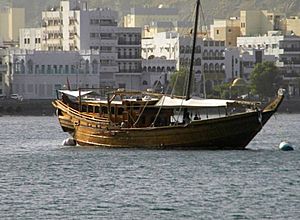
Outwardly, Oman shares many of the cultural characteristics of its Arab neighbours, particularly those in the Gulf Cooperation Council. Despite these similarities, important factors make Oman unique in the Middle East. These result as much from geography and history as from culture and economics. The relatively recent and artificial nature of the state in Oman makes it difficult to describe a national culture; however, sufficient cultural heterogeneity exists within its national boundaries to make Oman distinct from other Arab States of the Persian Gulf. Oman's cultural diversity is greater than that of its Arab neighbours, given its historical expansion to the Swahili Coast and the Indian Ocean.
Oman has a long tradition of shipbuilding, as maritime travel played a major role in the Omanis' ability to stay in contact with the civilisations of the ancient world. Sur was one of the most famous shipbuilding cities of the Indian Ocean. An al Ghanja ship takes one whole year to build. Other types of Omani ship include As Sunbouq and Al Badan.
Dress
The male national dress in Oman consists of the dishdasha, a simple, ankle-length, collarless gown with long sleeves. Most frequently white in colour, the dishdasha may also appear in a variety of other colours. Its main adornment, a tassel (furakha) sewn into the neckline, can be impregnated with perfume. Underneath the dishdasha, men wear a plain, wide strip of cloth wrapped around the body from the waist down. The most noted regional differences in dishdasha designs are the style with which they are embroidered, which varies according to age group. On formal occasions a black or beige cloak called a bisht may cover the dishdasha. The embroidery edging the cloak is often in silver or gold thread and it is intricate in detail.
Omani men wear two types of headdress:
- the ghutra, also called "Musar" a square piece of woven wool or cotton fabric of a single colour, decorated with various embroidered patterns.
- the kummah, a cap that is the head dress worn during leisure hours.
Some men carry the assa, a stick, which can have practical uses or is simply used as an accessory during formal events. Omani men, on the whole, wear sandals on their feet.
The Janbiya (dagger) forms part of the national dress and men wear the Janbiya on all formal public occasions and festivals. It is traditionally worn at the waist. Sheaths may vary from simple covers to ornate silver or gold-decorated pieces. A depiction of a Janbiya appears on the national flag.
Omani women wear eye-catching national costumes, with distinctive regional variations. All costumes incorporate vivid colours and vibrant embroidery and decorations. The Omani women's traditional costume comprises several garments: the kandoorah, which is a long tunic whose sleeves or radoon are adorned with hand-stitched embroidery of various designs. The dishdasha is worn over a pair of loose-fitting trousers, tight at the ankles, known as a sirwal. Women also wear a head shawl most commonly referred to as the lihaf.
As of 2014[update] women reserve wearing their traditional dress for special occasions, and instead wear a loose black cloak called an abaya over their personal choice of clothing, whilst in some regions, particularly amongst the Bedouin, the burqa is still worn. Women wear hijab, and though some women cover their faces and hands, most do not. The Sultan has forbidden the covering of faces in public office.
Music and cinema
Music of Oman is extremely diverse due to Oman's imperial legacy. There are over 130 different forms of traditional Omani songs and dances. The Oman Centre for Traditional Music was established in 1984 to preserve them. In 1985, Sultan Qaboos founded the Royal Oman Symphony Orchestra. Instead of engaging foreign musicians, he decided to establish an orchestra made up of Omanis. On 1 July 1987 at the Al Bustan Palace Hotel's Oman Auditorium the Royal Oman Symphony Orchestra gave its inaugural concert. In popular music, a seven-minute music video about Oman went viral, achieving 500,000 views on YouTube within 10 days of being released on YouTube in November 2015. The a cappella production features three of the region's most popular talents: Kahliji musician Al Wasmi, Omani poet Mazin Al-Haddabi and actress Buthaina Al Raisi.
The cinema of Oman is very small, there being only one Omani film Al-Boom (2006) as of 2007[update]. Oman Arab Cinema Company LLC is the single largest motion picture exhibitor chain in Oman.
Art
Traditional art in Oman stems from its long heritage of material culture. Art movements in the 20th century reveal that the art scene in Oman began with early practices that included a range of tribal handicrafts and self-portraiture in painting since the 1960s. However, since the inclusion of several Omani artists in international collections, art exhibitions, and events, such Alia Al Farsi, the first Omani artist to show at the last Venice Biennale and Radhika Khimji, the first Omani artist to exhibit at both the Marrakesh and Haiti Ghetto biennale, Oman's position as a newcomer to the contemporary art scene in recent years has been more important for Oman's international exposure.
Bait Muzna Gallery is the first art gallery in Oman. Established in 2000 by Sayyida Susan Al Said, Bait Muzna has served as a platform for emerging Omani artists to showcase their talent and place themselves on the wider art scene. In 2016, Bait Muzna opened a second space in Salalah to branch out and support art film and the digital art scene. The gallery has been primarily active as an art consultancy. The Omani Society for Fine Arts, established in 1993, offers educational programmes, workshops and artist grants for practitioners across varied disciplines.
The Sultanate's flagship cultural institution, the National Museum of Oman, opened on 30 July 2016 with 14 permanent galleries. It showcases national heritage from the earliest human settlement in Oman two million years ago through to the present day. The museum takes a further step by presenting information on the material in Arabic Braille script for the visually impaired, the first museum to do this in the Gulf region. Bait Al Zubair Museum is a private, family-funded museum that opened its doors to the public in 1998. In 1999, the museum received Sultan Qaboos' Award for Architectural Excellence. Bait Al Zubair displays the family's collection of Omani artifacts.
Omani cuisine
Omani cuisine is diverse and has been influenced by many cultures. Omanis usually eat their main daily meal at midday, while the evening meal is lighter. During Ramadan, dinner is typically served after the Taraweeh prayers, sometimes as late as 11 pm.
Arsia, a festival meal served during celebrations, consists of mashed rice and meat (sometimes chicken). Another popular festival meal, shuwa, consists of meat cooked very slowly (sometimes for up to 2 days) in an underground clay oven. Fish is often used in main dishes too, and the kingfish is a popular ingredient. Mashuai is a meal consisting of a whole spit-roasted kingfish served with lemon rice. Rukhal bread is a thin, round bread eaten at any meal, typically served with Omani honey for breakfast or crumbled over curry for dinner. The Omani halwa is a very popular sweet, consisting of cooked raw sugar with nuts. There are many different flavors, the most popular ones being black halwa (original) and saffron halwa. Halwa is considered a symbol of Omani hospitality, traditionally served with coffee.
Sports
In October 2004, the Omani government set up a Ministry of Sports Affairs to replace the General Organisation for Youth, Sports and Cultural Affairs. The 19th Arabian Gulf Cup took place in Muscat, from 4 to 17 January 2009 and was won by the Omani national football team. The 23rd Arabian Gulf Cup that took place in Kuwait, from 22 December 2017 until 5 January 2018 with Oman winning their second title, defeating the United Arab Emirates in the final.
Oman's traditional sports are dhow racing, horse racing, camel racing, bull fighting and falconry. Association football, basketball, waterskiing and sandboarding are among the sports that have emerged quickly and gained popularity among the younger generation. Oman, along with Fujairah in the UAE, are the only regions in the Middle East that have a variant of bullfighting, known as 'bull-butting', organised within their territories. Al-Batena area in Oman is specifically prominent for such events.
The Oman Olympic Committee played a major part in organising the highly successful 2003 Olympic Days, which were of great benefit to the sports associations, clubs, and young participants. The football association took part, along with the handball, basketball, rugby union, field hockey, volleyball, athletics, swimming and tennis associations. In 2010 Muscat hosted the 2010 Asian Beach Games. Oman featured a men's national team in beach volleyball that competed at the 2018–2020 AVC Beach Volleyball Continental Cup.
Oman also hosts tennis tournaments each year. The Sultan Qaboos Sports Complex stadium contains a 50-meter swimming pool that is used for international tournaments. The Tour of Oman, a professional cycling 6-day stage race, takes place in February. Oman hosted the Asian 2011 FIFA Beach Soccer World Cup qualifiers, where 11 teams competed for three spots at the FIFA World Cup. Oman hosted the Men's and Women's 2012 Beach Handball World Championships at the Millennium Resort in Mussanah, from 8 to 13 July. The first "El Clasico" to be played outside of Spain, was played on 14 March 2014, at the Sultan Qaboos Sports Complex.
Oman has competed repeatedly for a position in the FIFA World Cup, but have not yet qualified to compete in the tournament. In cricket, Oman qualified for the 2016 ICC World Twenty20 and the 2021 T20 Cricket World Cup. On 25 June 2021, it was confirmed that Oman will co-host the 2021 edition of the ICC Men's T20 World Cup alongside the United Arab Emirates. In 2024, Oman participated in the 2024 Touch Rugby World Cup in Nottingham, which was its first participation in an international rugby tournament.
Gallery
- Muscat, Oman
-
A mosque in Muscat, Oman
-
Mutrah Fort, Muscat, Oman
-
Al Ameen Mosque, Muscat, Oman
-
Sultan Qaboos Grand Mosque, Muscat, Oman
-
Sultan's Ship, Mutrah, Muscat, Oman
-
Al Amarat Hills, Muscat, Oman
-
Al Azaiba Beach, Muscat, Oman
-
Library of Sultan Qaboos Grand Mosque, Muscat, Oman
Related pages
Images for kids
-
The Portuguese Empire ruled Oman for 143 years (1507–1650).
-
The Sultan's Palace in Zanzibar, which was once Oman's capital and residence of its sultans
-
Sultan Said bin Taimur ruled from 1932 to 1970.
-
Nizwa Fort attacked by British Royal Air Force strike aircraft during Jebel Akhdar War.
See also
 In Spanish: Omán para niños
In Spanish: Omán para niños




